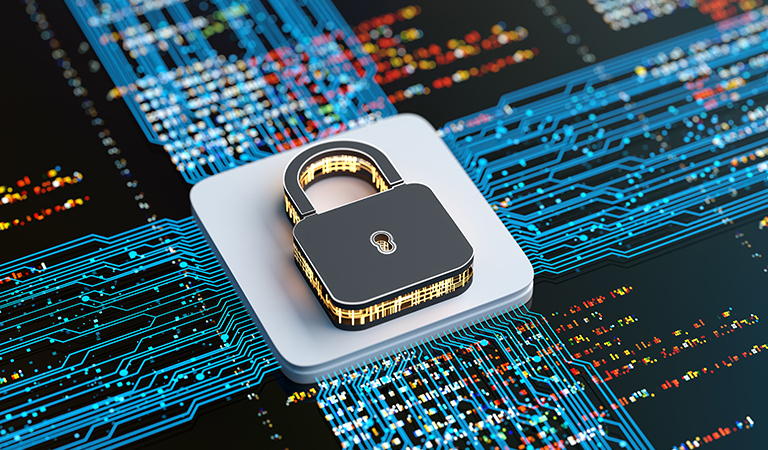
17 Apr 6 Cybersecurity Tips to Protect Your Eye Care Practice
Keeping your eye care practice safe from cybersecurity attacks, phishing scams, and cloud data breaches comes at a high cost in many ways. Cybercriminals are becoming more advanced in their approach, and healthcare providers need to ensure protecting their patient data is a top priority.
Certified ophthalmology and optometry cloud-based EHR and practice management software such as MaximEyes.com, which monitors and adheres to secure data protection, backup, and disaster recovery measures, will provide optimal protection. Not only is a powerful software system critical, but educating and training your staff on the risks of cyberattacks and what they should do to prevent them from happening is a step not to forget.
Below are six cybersecurity tips on protecting your eye care practice.
1. Educate your staff on the importance of cybersecurity.
According to a survey from Software Advice, one out of every four small medical practices has experienced a data breach, and 49% were caused by human error. Accenture’s State of Cybersecurity Resilience 2021 report states that security attacks increased by 31% from 2020 to 2021.
Hackers are constantly working on new ways to access your information. If you stay informed, you can build a more substantial barrier against them to secure your data.
Bring awareness to your staff on new cybersecurity threats that may be developing so your staff is more cautious when clicking through different websites or email links.
Read articles and blogs from cybersecurity companies that are frequently published to help you stay in the loop during busy schedules. Enroll your staff in online security awareness training. Investing time to teach your staff weekly or monthly about cybersecurity will prevent them from falling into the traps that cost you a lot of money and stress.
Be suspicious of phishing emails as scammers use email and text messages to trick you into giving personal and financial information. The Federal Trade Commission (FTC) provides tips on recognizing and avoiding phishing scams. Many phishing emails may look as if they come from someone you trust. Conduct regular phishing simulations with your staff by sending mock phishing emails to employees to educate them on identifying and reporting phishing threats.
Related: HIPAA Compliance Guide for Eye Care Professionals
2. Keep your patient EHR data safe with cloud-based storage and backups.
There are many benefits when using a cloud-based EHR and practice management software that prioritizes your security and data. One of those benefits is having a disaster recovery plan to ensure your data is always secure and available in case of a potential cyberattack, data breach, or even a computer failure. With a backup plan, recovery will be possible.
MaximEyes.com uses the Microsoft® Azure Advanced Threat Protection (ATP) cloud-based security solution to back up the last 30 days of your data. Data is autosaved and backed up in real-time. If a disaster occurs, you could typically recover your data within 2–8 hours.
“Protecting our patient data is critical due to potential cyberattacks and ransomware. MaximEyes.com always emphasizes secure data protection and disaster recovery and pays close attention to staying on top of security and privacy issues.” –Brad Bodkin, OD (read success story)
3. Set up two-factor or multi-factor authentication.
Most services you use online today will provide two-factor or multi-factor authentication (MFA) to reduce security risks when available. MFA adds a second layer of protection to verify your identity when accessing your accounts, making it extremely difficult for hackers to access your data.
The second method of verifying your identity is with a one-time code sent to your mobile device or email, a one-time passcode generated by an authenticator app, or by entering the answers to your security questions.
With MaximEyes.com, it is a requirement to use MFA to ensure that only authorized users that the system administrator has approved have access to patient records. Ensure your EHR and practice management software also provides this level of protection.
Related: Top 10 Optometry EHR Software Must-Haves
Related: Eye Care EHR Checklist: 5 Critical Steps to Consider Before Go-Live
4. Create strong passwords and security questions for each user.
If you have an ordinary and easy-to-remember password, consider changing it as soon as possible. To create a strong and secure password, use a mix of uppercase letters, lowercase letters, symbols, and numbers. Remember, the longer and the more complex your password is, the harder it will be for hackers to solve it.
Another option for creating strong passwords is using an online password generator that automatically creates one. An article by Electric recommends that you update your passwords every three months to ensure a hacker does not compromise your accounts.
If you need to remember complex passwords quickly, use an online password manager to avoid writing down your passwords. Online password managers will help you create strong passwords for multiple accounts and notify you of potential data leaks.
When it comes to security questions, it is essential to create personalized security questions that only you know the answers to in case you forget your password and need to reset it.
Immediately change your password if it is accidentally exposed or compromised. And upon termination and resignation of a staff member, immediately deactivate all passwords to prevent unauthorized access.
“Moving to MaximEyes.com, we no longer need to install, maintain, or back up our patient data—MaximEyes.com does it all on a secure cloud-based system. Now we focus on growth without breaking the bank.” –Peter Falk, OD (read success story)
5. Secure all office computers and mobile devices.

Never leave mobile computing devices (laptops, tablets, mobile phones, Bluetooth devices, memory cards, flash drives, and external hard drives) unattended or in an unsecured area. Always log off or lock computer access if you leave your desk unattended, even if it is only for a moment.
Most important, keep computer systems up-to-date with current operating system security patches, firewalls, and antivirus definitions.
6. Use a private and static IP address.
Always use a private network to be safe because public networks are not the most secure. Using a public network raises the chances of hackers capturing your data.
Your IP address is your online address and is essential when sending and receiving information. That is why using a private and static IP address will restrict your IP address, giving you peace of mind while navigating the internet. A private IP address is only accessed by someone on the same network you are using. A static IP address will never change while you use the same provider or stay on the same server.
With MaximEyes.com, add and manage your IP addresses anytime and from anywhere. Your EHR and practice management software should allow you to enter the IP addresses you will use to avoid network conflicts and ensure all devices work correctly.
Choose Certified Eye Care Software That Prioritizes Security
Implementing the security measures above will help you and your staff feel more confident when assisting patients and entering data into your EHR. First Insight is committed to ensuring MaximEyes.com ONC 2015 Edition Cures Update EHR complies with current certifications and clinical standards and adheres to IHE standards to safely and securely exchange patient data.
Book a phone call with a MaximEyes.com representative for a quick chat or request more information to see how we help your practice become more efficient, productive, and secure.





